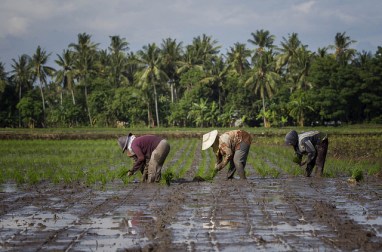 Farmers planting rice in South Sulawesi, Indonesia. Photo by: Tri Saputro / CIFOR
Farmers planting rice in South Sulawesi, Indonesia. Photo by: Tri Saputro / CIFOR
Yusup was 23 and working far from home in Japan when he spotted an unusual opportunity. He kept hearing that young people from his home region in West Java, Indonesia, were abandoning their family farms to work in factories. Yusup took the money he’d earned abroad and invested it, purchasing a rice farm and opening a farming supply shop in West Java. Today, Yusuf’s business generates 25 million rupiahs per month (about $1,900) with a 15 percent profit.
The key to his success? The integration of farming, input sale and advisory services, and the leadership of a farmer group connected to other farmers in the region. Through his success, he became a spokesperson to encourage other young people to participate in their agricultural economy. This International Youth Day, we need to recognize ambitious and innovative youth like Yusup and re-evaluate our own strategies for fostering the next generation of entrepreneurs — particularly in farming and agriculture.
Financial opportunities in agriculture are growing. To keep up with current population growth, global food production must increase by 70 percent by 2050. Despite the growing market, the average age of farmers in the world today is 60. When young people think of money, they may not think of cows, or rice, or chickens. But they should.
The general consensus around youth perceptions of agricultural production is that the majority of youth would like to transition out of the sector. Broad sweeping generalizations highlight that youth are disinterested in agriculture and discouraged by the difficulty of the work, social stigmas and the challenges faced in earning a suitable income. However, recent research by my organization, Mercy Corps, in Liberia found that young people identified work in agriculture as popular and “the surest way of getting rich.”
Engaging youth in agriculture is critical if we are to renew the farming generation and help young people, their families and the rest of the world access food, increase income and ultimately build long-term food security and resilience.
We need more young people like Yusup — and we need to reflect on how we are helping them succeed. We need to harness youth’s motivation, their eagerness to learn and their innovative spirit to transform and revolutionize the agriculture sector. As practitioners we also must engage youth more meaningfully in farming, as well as in agriculture markets, which can provide young people not simply with income, but also with work that is significant, respectable and attractive.
The development community today must make a concerted effort to better understand youth perceptions of agriculture, and then step up its game in creating innovative ways to better engage young people. Many programs targeting youth focus on employment and entrepreneurship, but with no specific support for agriculture work in areas where there is huge opportunity. Most agriculture programs consider youth as a subset of broader support to all farmers, and as a vulnerable group (alongside women) that may need attention. But this attention is most often translated into ensuring representation of youth in mixed-age farmer groups, based on artificial quotas, without adapting programs specifically to youth needs.
When involving youth in agriculture programing, here are five things practitioners should consider.
1. Understanding that not all youth are equal — and targeting to their specific assets and capacities.
Youth are not a homogenous cohort and programs must be designed with diverse offerings that can engage youth with various degrees of technical skill, differing access to assets and finances, and different aspirations. Young women from Pokot in Kenya are more interested in raising chickens, given their control over this asset and use for feeding their families, whereas young men in Liberia dream of tree crop farms that will help them purchase a motorbike and increase their income.
2. Integrating skill development and opportunities for agricultural education.
While we all know that diverse topics such as technical, business and personal skills are the cornerstone of skill development for youth, we need to ensure that these are taught and disseminated in a way that encourages them to discover, test, apply and innovate. Reality TV competitions such as ”Don’t Lose the Plot” in Kenya or videos in Guatemala are one of the innovative ways of motivating youth and teaching them new skills.
3. Adapting farming systems that stagger income streams.
Integrated and diversified farming systems provide for immediate income needs, while also investing in longer term and more profitable endeavors. We need to recognize the importance of supplementary work and help youth build, manage and strengthen their portfolios of work to stabilize income while simultaneously encouraging them to remain in agriculture. This means providing access to sufficient information on potential economic opportunities and subsequently supporting them in pursuing multiple investments.
4. Developing social networks is important.
In technology-based or traditional youth groups such as the kuus in Liberia or bunges in Kenya, youth rely on social networks, peer-to-peer mentoring and role models to think through their future and develop their understanding of livelihood options. These social networks give them a voice within their household, their community and the broader economic community.
5. Ensuring special protection support for young women.
By expanding young women and girls’ mobility and relationships, both within their community and beyond, we increase their risks. It is important to work with girls to identify those risks and potential solutions. By creating safe transport, we can provide safer ways to go to the market. And by sensitizing elders and young boys, we can help the community find solutions, such as hotlines in Uganda or safe spaces in Niger.
On International Youth Day — and every day — young people deserve our attention. Making agriculture fun, modern and a sure way to participate in the economy will help youth feel motivated, stay engaged and be productive. But this requires more thinking from our side — not just applying the same old technique, but listening to youth aspirations and needs, adapting our methodologies, facilitating learning and rewarding success.









